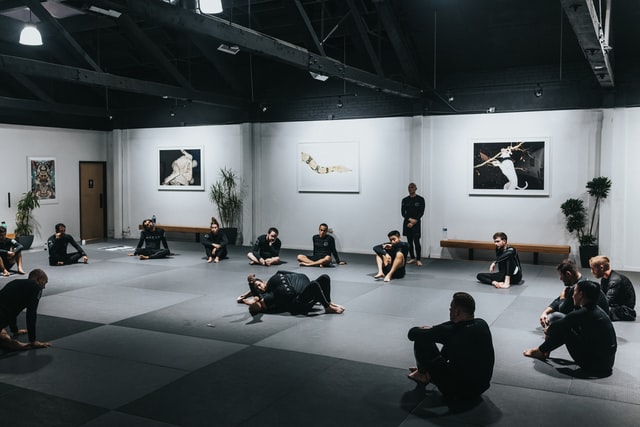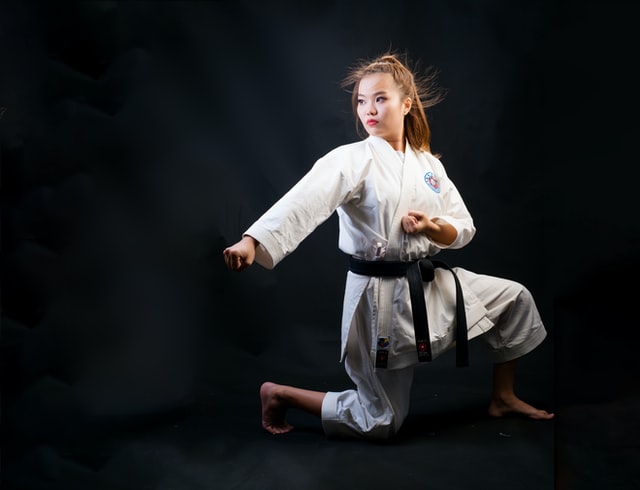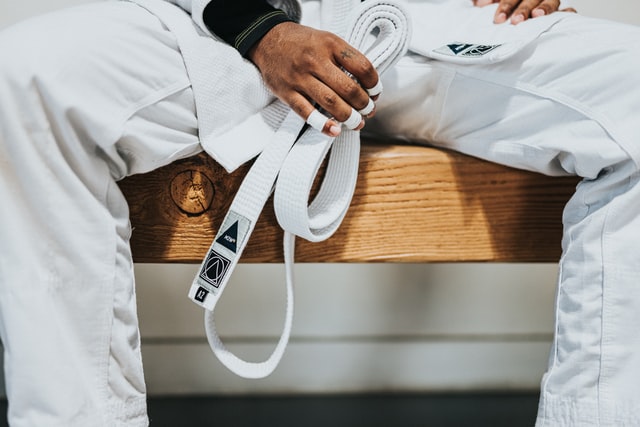Brazilian jiu-jitsu might be the perfect choice for women wanting to get stronger, easily handle everyday chores, and learn some cool self-defense moves.
Even if you've learned some self-defence techniques in the past but want to improve your skills, this martial art is highly suitable for you.
Unlike Japanese jiu-jitsu, which has several different branches and requires an enormous amount of training and time to master, Brazilian jiu-jitsu focuses on one aspect: grappling.
Still, it has developed with time and has more than 600 techniques for you to master.
After attending classes, you can easily and efficiently defend yourself against heavier, bigger, and stronger opponents.
Moreover, there are ways to train faster and smarter in BJJ. For instance, you can use BJJ FlowCharts for quick solutions to your training problems.
For more information about these FlowCharts, check out the best BJJ flowcharts review.
So let’s delve in and tell you everything you need to know before you start your BJJ self-defence classes.

Table of Contents
What is Brazilian jiu-jitsu?
Brazilian jiu-jitsu, or BJJ, is a martial art that combines ground-based fighting techniques with a set of submission holds. It also uses proper timing, leverage, pressure, and weight distribution to deal with opponents efficiently.
We can trace its origin back to the 1920s. Initially, it came from Japanese jiu-jitsu, a martial art that taught everything one needed to excel on the battlefield.
In other words, it was the training system of the feudal samurai!
In contrast, Brazilian jiu-jitsu focuses more on the practical aspects and grappling techniques of Japanese jiu-jitsu.
Moreover, BJJ evolved with time, and after the UFC brought mixed martial arts in the 1990s, it became popular worldwide due to its convenience. As such, nowadays, the majority of the UFC fighters train in Brazilian jiu-jitsu.
Where do you learn women's Brazilian jiu-jitsu?
Typically, the best place to learn women's Brazilian jiu-jitsu is a BJJ training school. But you can also learn it at home with the assistance of skilled, experienced instructors.
After all, this martial art is convenient for most people, so most MMA and BJJ training institutes focus on teaching it cleanly and safely. But, on the other hand, practicing it at home is a bit more complicated since you may not have different sparring partners.
Still, you'll need to take proper safety measures to reduce the risk of injury, whether you learn it at home or in school.
For instance, you may want to pick up suitable BJJ Gi and protective gear.

Is there a difference between men's BJJ and women's BJJ?
Brazilian jiu-jitsu is a sport for everyone, regardless of gender. Weight and muscle density play a part when grappling, but besides these, there isn't much difference between men's and women's BJJ.
Moreover, since BJJ is a technique-oriented martial art, practicing with like-minded people who wish to improve their skills is better.
Furthermore, every trainee needs to leave their ego at the door of the training school to learn appropriately. This way, men and women can adapt and develop their grappling techniques more efficiently.
What's the difference between jiu-jitsu for self-defence and Brazilian jiu-jitsu?
It's common for beginners to confuse jiu-jitsu for self-defense and Brazilian jiu-jitsu. After all, they have some striking similarities, yet they are also very different.
For instance, both Japanese jiu-jitsu and BJJ have several chokes and strangles.
In contrast, jiu-jitsu self-defence includes striking, throwing, and traditional weapons training, while BJJ focuses on ground-based fighting and grappling.
So, Brazilian jiu-jitsu is more suitable for most people with limited time for training and sparring.
How different is Brazilian jiu-jitsu from other self-defence training for women?
Over the last few years, Brazilian jiu-jitsu has become increasingly popular for teaching women self-defence due to its excellent efficiency. It's not only practical but also allows women with a lighter build to use technique and leverage to grapple with much larger opponents.
Thus, it's slightly different from most martial arts that depend on strength conditioning and muscle power to dominate the ring or mat.
Additionally, it's easier to train in BJJ since it's similar to Judo. Having some Judo knowledge would be even better since it'll let you become a better submission hunter.
Other self-defence training for women includes Krav Maga. Which is used by military forces and civilians to defend themselves in real-life emergencies.

Will I get hurt during my BJJ class?
While the risk is low, it's uncommon to suffer light injuries during a BJJ class. After all, it's a contact sport with powerful grappling techniques that require you to use submission holds.
Nevertheless, preparing the proper safety gear can prevent most of these injuries.
Furthermore, you'll have to take extra care if you plan to wear glasses or contact lenses during a sparring session.
However, most of the experienced instructors in a BJJ class will be able to help you in an emergency.
Overall, you may suffer slight injuries during your BJJ class, but they'll most likely be less than what you would face in a Taekwondo class.
Should I train with men or just other women?
BJJ is a technique-based sport, so you can safely train with men and women.
However, if you are a beginner, you may want to get pointers from an experienced instructor before rolling with anyone. Otherwise, you may have an injured joint or muscle pain regardless of who you spar with on the mat.
In addition, men's and women's Brazilian jiu-jitsu are not significantly different. Thus, you can train with everyone or only with other women without hassle.

Do I need prior self-defence experience?
It's not necessary to have prior self-defence experience to learn BJJ. But if you have some martial arts training, the learning process will be much easier.
Specifically, if you have a Judo or Japanese Jiu-Jitsu background, you can pick up most of the grappling and ground fighting basics without too much trouble.
Moreover, if you've learned other effective self-defence systems, you can use your sharpened reflexes and superior balance, motion to progress faster.
In contrast, if you are new to this sport, completing the basic beginner-level training may take about 108 days. Afterward, it typically takes 2-3 years to gain enough proficiency to earn the blue belt.
So, in a nutshell, you won't need prior self-defence experience to learn Brazilian jiu-jitsu.
Five tips and tricks to help BJJ beginners
To a beginner, BJJ can seem pretty intimidating at first glance. But, with a few tips and tricks, you'll be able to learn this fantastic martial art more safely and efficiently.
Therefore, in this section, we've included 5 tips to make your learning process smoother and reduce the risk of injuries.
Shorten your fingernails and toenails
Before attending a BJJ class or sparring session, make sure your nails are trimmed. This way, you won't accidentally injure your opponent or suffer a broken nail.
Make a chart of your weekly training
Plan your schedule accordingly. After all, a timely program will improve your reflexes and muscle memory faster without harming your daily life.
Never skip the warm-up session
Always remember to stretch and do a light warm-up before you train. It'll help you get the heart racing and increase oxygen intake.
This extra oxygen will allow you to perform better during training.
Wear appropriate clothing
Wearing clean BJJ Gi and appropriate protective gear when sparring will help avoid injury.
Pay attention to your instructors
You may want to pay close attention to your instructors and grapplers with more experience. After all, they can quickly detect flaws in your stance and techniques and provide you with practical solutions.

Bottom line
Learning Brazilian jiu-jitsu lets you defend yourself and allows you to have a better boost of confidence. Moreover, BJJ self-defense classes for women offer numerous physical and psychological benefits.
Nevertheless, following the basic rules and safety measures when learning such martial arts is essential.
After all, even slight mistakes can cause severe injuries if you are not careful when fighting on the ground with powerful submission holds.
Thus, ensure that you learn from experienced instructors to minimize the risk of injuries. Once you have completed these steps, you'll be free to learn one of the most dominant martial arts of our current time.
So, give it a try and join your BJJ self-defence class today!
I'm Andrew, the entrepreneurial mind behind AV SEO Consultant Boutique Agency, with a deep-rooted love for cats and a knack for crafting the perfect home office. As the co-founder of Brazilian Jiu-Jitsu World, my expertise has evolved from the mat to the digital realm, where I now leverage my SEO savvy to empower others. Though injury may have paused my BJJ and MMA journey, my commitment to sharing actionable insights and resources for these passions remains unshaken.





